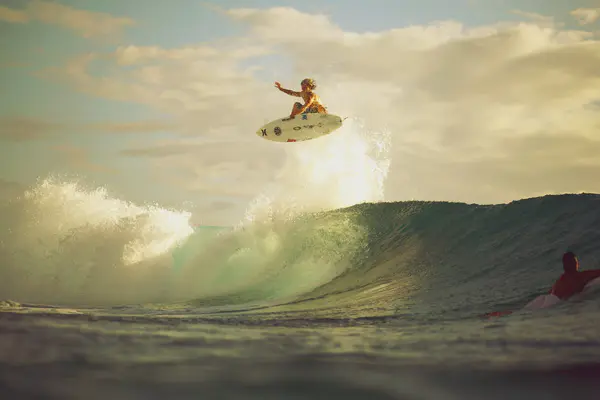Surfing is a water sport. It involves riding waves. Surfers use a surfboard. The goal is to stay on the board. Surfers aim to ride the wave’s unbroken part. This is called the “face” of the wave. Surfing has a long history. It began in Polynesia. It spread to Hawaii. Now, it is popular worldwide.
The Basics of Surfing
Surfboards
Surfboards come in different shapes and sizes. There are longboards and shortboards. Longboards are easier for beginners. Shortboards are for advanced surfers. The type of surfboard affects how you surf.
Waves
Waves are the essence of surfing. They are created by wind. The size and shape of waves vary. Some are big and powerful. Others are small and gentle. Surfers choose waves based on their skill level.
Surfing Techniques
Surfing techniques are essential. Beginners learn to paddle first. Paddling helps surfers catch waves. Next, they learn to pop up. Popping up means standing on the board. Balance is crucial. Advanced techniques include carving and cutbacks.
Understanding Surfing Terms
Common Surfing Terms
Surfing has its own language. Here are some common terms:
- Lineup: The area where surfers wait for waves.
- Set: A group of waves.
- Duck Dive: A technique to go under waves.
- Wipeout: Falling off the surfboard.
Advanced Surfing Terms
Advanced surfers use specific terms:
- Barrel: When the wave forms a tube.
- Aerial: Jumping above the wave.
- Bottom Turn: A turn at the bottom of the wave.
- Floater: Riding the top of a breaking wave.
The Significance of P1 in Surfing
Definition of P1
P1 is a term in competitive surfing. It stands for Priority One. It indicates the surfer’s priority in catching waves. The surfer with P1 has the right of way. Other surfers must yield.
How P1 is Determined
P1 is determined by competition rules. Judges decide who has P1. It is usually based on performance. The surfer with the highest score may get P1. P1 can change during the competition.
Importance of P1
P1 is crucial in competitions. It allows surfers to choose the best waves. This can affect their scores. Having P1 gives a competitive edge. It reduces interference from other surfers.
The Role of Judges in Surfing Competitions
Judging Criteria
Judges evaluate surfers based on criteria:
- Wave Selection: Choosing the best waves.
- Maneuvers: Performing tricks and techniques.
- Style: The surfer’s overall presentation.
- Consistency: Maintaining performance throughout the heat.
Scoring System
Surfers are scored on a scale. The highest possible score is 10. Judges score each wave. The best two waves are counted. The total determines the surfer’s rank.
Changing Priorities
Priorities can change. Judges monitor surfers. They can reassign P1. It keeps the competition fair. Surfers must be aware of their priority status.
Strategies for Maintaining P1
Wave Selection
Choosing the right wave is key. Surfers with P1 have an advantage. They can pick the best waves. Good wave selection leads to higher scores.
Timing
Timing is crucial. Surfers must catch waves at the right moment. Being too early or too late can be costly. Perfect timing maximizes wave potential.
Execution
Executing maneuvers perfectly is essential. Judges look for precision. High-quality maneuvers score better. Surfers with P1 must perform consistently.
See Also: What Is a Kook in Surfing Terms
Challenges in Maintaining P1
- Competition Pressure: Competition pressure is intense. Surfers with P1 are under scrutiny. They must perform well. Pressure can lead to mistakes.
- Wave Conditions: Wave conditions are unpredictable. They change frequently. Surfers must adapt quickly. Poor conditions can affect performance.
- Interference: Interference from other surfers is common. Even with P1, interference happens. Judges penalize interference. Surfers must be cautious.
Training for Competitive Surfing
Physical Fitness
Physical fitness is vital. Surfers need strength and endurance. Training includes swimming and paddling. Core exercises improve balance.
Practice Sessions
Practice sessions are essential. Surfers train in various conditions. They simulate competition scenarios. Practice improves skills and confidence.
Mental Preparation
Mental preparation is crucial. Surfers need focus and composure. Techniques like visualization help. Staying calm under pressure is important.
The Evolution of Surfing Competitions
Historical Perspective
Surfing competitions have evolved. Early contests were simple. They focused on wave riding. Modern competitions are complex. They include various categories.
Modern Competitions
Modern competitions are well-organized. They have strict rules. Technology plays a role. Scoring is precise. Competitions attract global participants.
Future Trends
The future of surfing competitions is exciting. Innovations continue. New formats and technologies emerge. The sport keeps growing in popularity.
The Impact of Technology on Surfing
- Surfboard Design: Technology improves surfboard design. Modern materials enhance performance. Shaping techniques are advanced. Customization is possible.
- Wave Pools: Wave pools are a breakthrough. They provide consistent waves. Surfers can train year-round. Competitions are held in wave pools.
- Performance Analysis: Performance analysis is advanced. Surfers use video reviews. Coaches provide feedback. Data analysis helps improve skills.
Conclusion
P1 is a critical concept in competitive surfing. It signifies priority in catching waves. Understanding P1 is essential for competitors. It influences strategy and performance. Competitive surfing requires skill, fitness, and mental strength. The sport continues to evolve with technology. Surfers must adapt and innovate.

